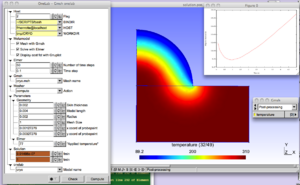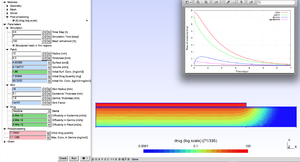Elmer
Contents
Introduction
Elmer is an open source (GPL) computational tool for multi-physics problems. It is developed by CSC in collaboration with Finnish universities, research laboratories and industry. To test ONELAB models working with Elmer, a working installation of the software on your system is required. As a one-size-fits-all solution for all interfaced clients, a specific virtual machine, called OLVM, has been designed to have ONELAB models and client software installed on it with minimal user interaction. You first need to install the empty virtual machine on your system by following these instructions. When done, you can proceed with the installation of Elmer, and the download of benchmark ONELAB models, by following the instructions below.
Installation
Everything is configured in the Virtual machine so that the installation of Gmsh and Elmer is done by issuing simple commands in a terminal. Open a terminal by clicking on the "terminal" icon in the launcher panel and issue the command
install_gmsh.sh
at the prompt. This will download the nightly-build of Gmsh from http://geuz.org/gmsh, install it, and place a Gmsh icon on the Desktop.
When done, issue the command
install_elmer.sh
which will download the source code of Elmer and compile it. This may take several minutes.
Finally, a number of Elmer models are downloaded and executed to check the installation by issuing the command
testModels.sh
at the prompt. This may again take a few minutes. After all, you have a directory "OLTESTS" in your home directory with a number of Elmer models, which are now presented with more details.
ONELAB models
CRYO
The physical background is the cryogenic treatment of warts by application of a cryogenic fluid. The idea is to maximize the destruction of wart tissue cells while minimizing damages to healthy skin tissue. A damage function depending on temperature distribution and exposure time is built to represent this trade-off. The purpose of the modeling is to determine the application time that minimizes the damage function.
Various geometrical and modeling parameters can be interactively modified in the ONELAB window. After execution, a plot of the damage function vs. time is displayed and the computed optimum application time tmin is shown in the ONELAB window in the highlighted box.
Launch Gmsh and open OLMODELS/CRYO/cryo.py from the "File" menu.
BEAM
Download and inflate the archive BEAM.zip in a work directory. Right-click on the icon cryo.ol and open the file with gmsh. Alternatively, start gmsh and click File > Open > cryo.ol from the menu.
This model is the didactical analysis of a clamped beam (static 3D elasticity). The dimensions of the beam and the material parameter can be modified interactively in the ONELAB window, as well as a number of modeling parameters. Diagrams of the internal moments can be generated. Check for this the box Compute MT diagrams, click on Check, and then on Run.
PATCH
This metamodel is toolkit for drug patch conception.
The user can determine the geometry of the patch and initial drug concentrations.
A number of drugs are pre-tabulated with their diffusivities.
Elmer solves a convection-diffusion equation and post processing tools display the rate at which drug is transmitted to the skin.
LASER
Download and inflate the archive LASER.zip in a work directory. Right-click on the icon laser.ol and open the file with gmsh. Alternatively, start gmsh and click File > Open > laser.ol from the menu.
The physical background of this model is the laser stimulation of skin in order to measure the density of nociceptive receptors. For a correct interpretation of the experimental data, an accurate knowledge of the temperature distribution in time and across the skin is needed. The metamodel allows selecting various laser types (Gaussian, flat-top) and various stimulus characteristics (imposed flux or controlled temperature). Each simulation generates a graphical result file plot.pdf that is directly interpretable by clinicians.

